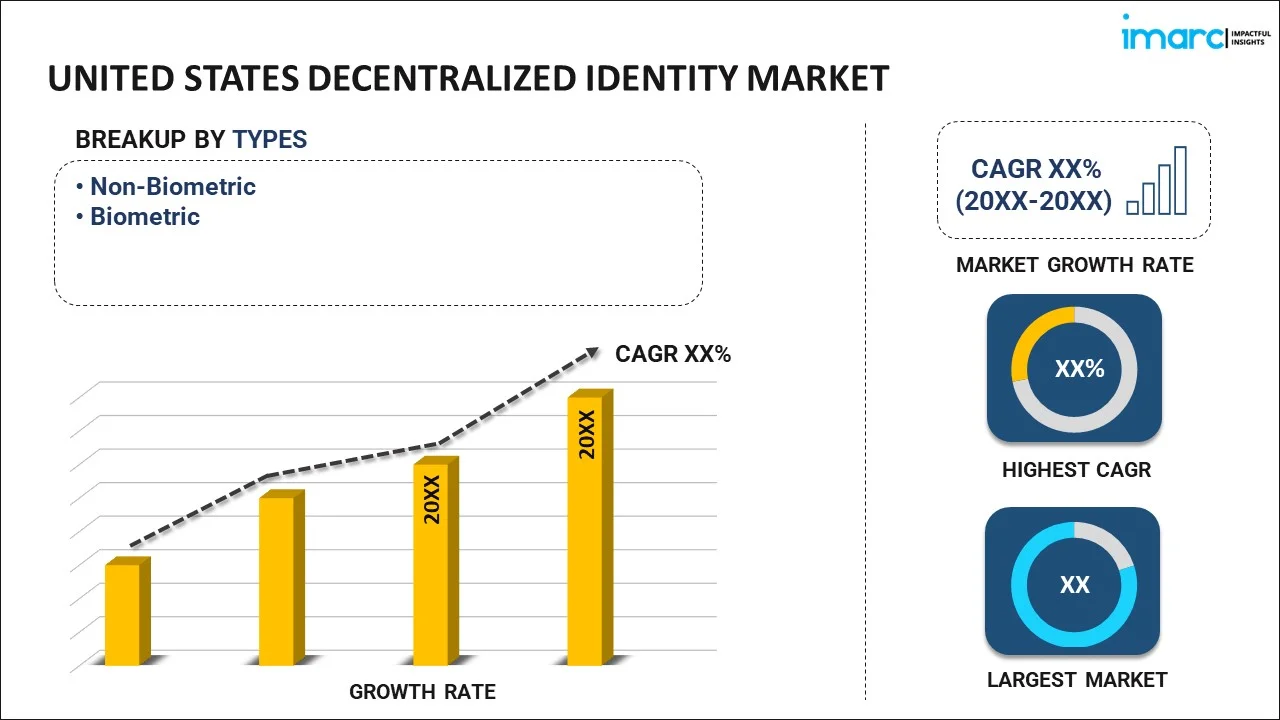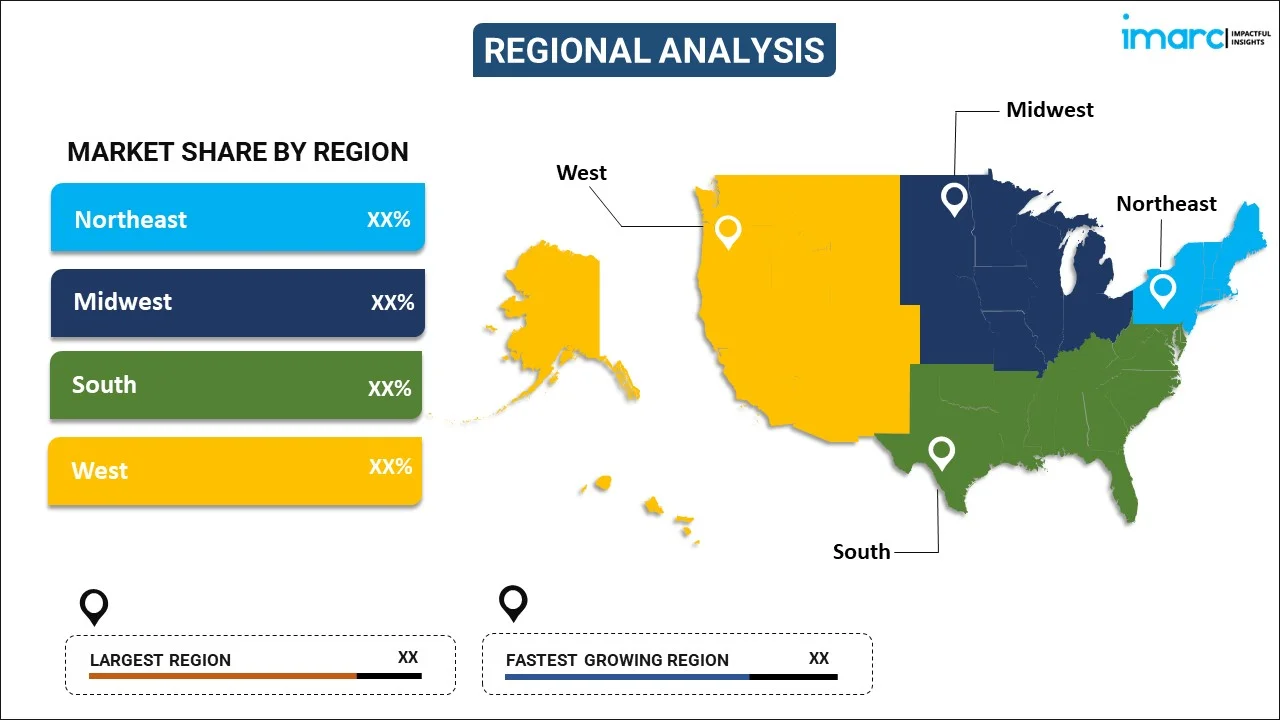
United States Decentralized Identity Market Report by Type (Non-Biometric, Biometric), Enterprise Size (Large Enterprises, Small and Medium-sized Enterprises), Vertical (BFSI, Government, Healthcare and Life Sciences, Telecom and IT, Retail and E-Commerce, Transport and Logistics, Real Estate, Media and Entertainment, Travel and Hospitality, and Others), and Region 2024-2032
Market Overview:
The United States decentralized identity market size is projected to exhibit a growth rate (CAGR) of 90.70% during 2024-2032. The escalating prevalence of digital transactions and the need for secure online identities, rapid technological advancements, rising concern over data privacy and security, and the implementation of several government initiatives represent some of the key factors driving the market.
|
Report Attribute
|
Key Statistics
|
|---|---|
|
Base Year
|
2023 |
|
Forecast Years
|
2024-2032
|
|
Historical Years
|
2018-2023
|
| Market Growth Rate (2024-2032) | 90.70% |
Decentralized identity refers to a digital identity model that shifts control and management from centralized authorities to individuals. It leverages blockchain technology and distributed ledgers to create a user-centric system, enabling individuals to own, control, and share their data securely and efficiently. Decentralized identity is available in various types, including self-sovereign identity (SSI), blockchain-based identity documents (IDs), and peer-to-peer identity networks. It exhibits core properties like security, privacy, user control, interoperability, and scalability through cryptographic keys, smart contracts, and decentralized apps (DApps). Decentralized identity finds applications in numerous fields, such as online authentication, financial services, healthcare, government services, supply chain management, education, voting systems, social media, and digital rights management. It aids in enhancing security, reducing the risk of data breaches, increasing privacy, eliminating intermediaries, and improving compliance with data protection regulations. Moreover, decentralized identity is lauded for its resilience to centralized system failures, empowerment of users in data management, facilitation of seamless cross-border transactions, support for a more inclusive digital economy, and reduction in administrative costs.
United States Decentralized Identity Market Trends:
The escalating prevalence of digital transactions and the need for secure online identities are major factors driving the market growth. Along with this, rapid technological advancements in blockchain and distributed ledger technology (DLT), enabling more robust and scalable decentralized identity solutions are creating a positive outlook for the market growth. Besides this, the rising concern over data privacy and security, propelling the demand for decentralized identity solutions that enhance security through encryption and reduce reliance on centralized databases, is fostering the market growth. Moreover, the growing adoption of decentralized identity in the financial sector, driven by the need for secure customer identification and compliance with regulatory frameworks is providing a thrust to the market growth. Besides this, the growing adoption of decentralized identity in the healthcare sector for managing patient data securely, fostering interoperability among different systems and ensuring patient privacy is positively impacting the market growth. Furthermore, the implementation of several government initiatives towards digital transformation and providing citizens with secure digital identifications (IDs) are boosting the market growth. In addition to this, the widespread integration of artificial intelligence (AI) and machine learning (ML) with decentralized identity systems to enhance identity verification processes and fraud detection is providing an impetus to the market growth. Additionally, the rising popularity of the gig economy and remote work, creating a demand for reliable digital identity verification methods, is fueling the market growth. Besides this, the increasing awareness about data rights, prompting consumers to favor platforms that offer transparency and data ownership, is supporting the market growth.
United States Decentralized Identity Market Segmentation:
IMARC Group provides an analysis of the key trends in each segment of the market, along with forecasts at the country level for 2024-2032. Our report has categorized the market based on type, enterprise size, and vertical.
Type Insights:

- Non-Biometric
- Biometric
The report has provided a detailed breakup and analysis of the market based on the type. This includes non-biometric and biometric.
Enterprise Size Insights:
- Large Enterprises
- Small and Medium-sized Enterprises
A detailed breakup and analysis of the market based on the enterprise size have also been provided in the report. This includes large enterprises and small and medium-sized enterprises.
Vertical Insights:
- BFSI
- Government
- Healthcare and Life Sciences
- Telecom and IT
- Retail and E-Commerce
- Transport and Logistics
- Real Estate
- Media and Entertainment
- Travel and Hospitality
- Others
The report has provided a detailed breakup and analysis of the market based on the vertical. This includes BFSI, government, healthcare and life sciences, telecom and IT, retail and E-commerce, transport and logistics, real estate, media and entertainment, travel and hospitality, and others.
Regional Insights:

- Northeast
- Midwest
- South
- West
The report has also provided a comprehensive analysis of all the major regional markets, which include Northeast, Midwest, South, and West.
Competitive Landscape:
The market research report has also provided a comprehensive analysis of the competitive landscape in the market. Competitive analysis such as market structure, key player positioning, top winning strategies, competitive dashboard, and company evaluation quadrant has been covered in the report. Also, detailed profiles of all major companies have been provided.
United States Decentralized Identity Market Report Coverage:
| Report Features | Details |
|---|---|
| Base Year of the Analysis | 2023 |
| Historical Period | 2018-2023 |
| Forecast Period | 2024-2032 |
| Units | US$ Million |
| Scope of the Report | Exploration of Historical and Forecast Trends, Industry Catalysts and Challenges, Segment-Wise Historical and Predictive Market Assessment:
|
| Types Covered | Non-Biometric, Biometric |
| Enterprise Sizes Covered | Large Enterprises, Small and Medium-sized Enterprises |
| Verticals Covered | BFSI, Government, Healthcare and Life Sciences, Telecom and IT, Retail and E-Commerce, Transport and Logistics, Real Estate, Media and Entertainment, Travel and Hospitality, Others |
| Regions Covered | Northeast, Midwest, South, West |
| Customization Scope | 10% Free Customization |
| Report Price and Purchase Option | Single User License: US$ 3699 Five User License: US$ 4699 Corporate License: US$ 5699 |
|
Post-Sale Analyst Support |
10-12 Weeks |
| Delivery Format | PDF and Excel through Email (We can also provide the editable version of the report in PPT/Word format on special request) |
Key Questions Answered in This Report:
- How has the United States decentralized identity market performed so far and how will it perform in the coming years?
- What has been the impact of COVID-19 on the United States decentralized identity market?
- What is the breakup of the United States decentralized identity market on the basis of type?
- What is the breakup of the United States decentralized identity market on the basis of enterprise size?
- What is the breakup of the United States decentralized identity market on the basis of vertical?
- What are the various stages in the value chain of the United States decentralized identity market?
- What are the key driving factors and challenges in the United States decentralized identity?
- What is the structure of the United States decentralized identity market and who are the key players?
- What is the degree of competition in the United States decentralized identity market?
Key Benefits for Stakeholders:
- IMARC’s industry report offers a comprehensive quantitative analysis of various market segments, historical and current market trends, market forecasts, and dynamics of the United States decentralized identity market from 2018-2032.
- The research report provides the latest information on the market drivers, challenges, and opportunities in the United States decentralized identity market.
- Porter's five forces analysis assist stakeholders in assessing the impact of new entrants, competitive rivalry, supplier power, buyer power, and the threat of substitution. It helps stakeholders to analyze the level of competition within the United States decentralized identity industry and its attractiveness.
- Competitive landscape allows stakeholders to understand their competitive environment and provides an insight into the current positions of key players in the market.
Need more help?
- Speak to our experienced analysts for insights on the current market scenarios.
- Include additional segments and countries to customize the report as per your requirement.
- Gain an unparalleled competitive advantage in your domain by understanding how to utilize the report and positively impacting your operations and revenue.
- For further assistance, please connect with our analysts.
 Inquire Before Buying
Inquire Before Buying
 Speak to an Analyst
Speak to an Analyst
 Request Brochure
Request Brochure
 Request Customization
Request Customization




.webp)




.webp)












